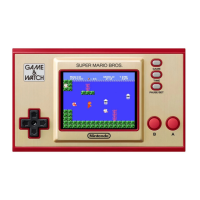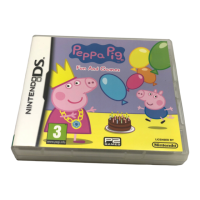Do you have a question about the Nintendo Super Mario Bros and is the answer not in the manual?
Provides contact details for Nintendo Customer Service, including phone numbers and website for assistance.
Advises on preventing seizures, listing symptoms and precautions for video gaming.
Offers guidance to avoid physical discomfort and injuries from prolonged gaming sessions.
Details risks of battery leakage and necessary precautions to avoid harm.
Warns about potential interference with medical devices from wireless features.
Explains how to choose between Mario Game, Vs. Luigi, and Minigames.
Overview of the single-player mode focused on rescuing Princess Peach.
Details the two-player competitive mode for collecting Big Stars.
Introduces the minigame mode for up to four players.
Allows adjustment of game sound and control settings.
Details button inputs for navigating menus and interacting with game elements.
Explains how to activate Sleep Mode for saving progress and conserving battery.
Guides users through inserting the game card, powering on, and selecting the game.
Allows users to modify sound settings and choose preferred control schemes.
Introduces the game's narrative premise involving Princess Peach's disappearance.
Instructions on how to begin playing the single-player Mario game mode.
Explains how to create, copy, or erase game save files.
Details the map screen showing course progress, collectibles, and world progression.
Describes boss battles and the function of Star Coins for unlocking new paths.
Explains map icons for ? Blocks, Hammer Bros., and items from Toad Houses.
Details elements like coins, lives, time, score, and progress bar during gameplay.
Explains midway points, course goals, losing lives, and game over conditions.
Details options available when pausing the game, such as continuing, returning to map, or quitting.
Lists various items like ? Blocks, Coins, Starman, and power-ups found in courses.
Learn fundamental movements like walking, dashing, ducking, and jumping.
Explains advanced moves like hitting blocks, double jumps, ground pounds, slides, and wall jumps.
Covers actions like entering pipes, swimming, swinging on ropes, and climbing.
Details grabbing items, hitting fences, and using flip panels.
Explains hanging on ledges and climbing ropes for traversal.
Describes Mario in his default state and the consequences of taking damage.
Explains how to use Mega Mushrooms for colossal size and enhanced abilities.
Details the abilities and gameplay of Mini Mario after consuming a Mini Mushroom.
Explains the shell dash ability and mechanics of Shell Mario.
Guides on establishing wireless connections for DS Game Card and Download Play.
Allows customization of game rules like wins, Big Stars, lives, and course selection.
Explains how to read on-screen indicators for stars, lives, coins, and player positions.
Details competitive multiplayer minigames played with DS Game Cards or Download Play.
Describes single-player minigames accessible through various modes.
Explains random game assortment (Shuffle) and one-at-a-time play (Free Play).
Step-by-step instructions for setting up wireless multiplayer using Game Cards.
Instructions for enabling multiplayer via Download Play without individual Game Cards.
Provides essential rules and warnings for using wireless features, especially near medical devices.
Explains the wireless signal strength indicator and its meaning during gameplay.
Covers legal restrictions on copying software and using unauthorized accessories.
Outlines hardware and game warranty periods, limitations, and service information.
Provides contact details for Nintendo Customer Service, including phone numbers and website for assistance.
Advises on preventing seizures, listing symptoms and precautions for video gaming.
Offers guidance to avoid physical discomfort and injuries from prolonged gaming sessions.
Details risks of battery leakage and necessary precautions to avoid harm.
Warns about potential interference with medical devices from wireless features.
Explains how to choose between Mario Game, Vs. Luigi, and Minigames.
Overview of the single-player mode focused on rescuing Princess Peach.
Details the two-player competitive mode for collecting Big Stars.
Introduces the minigame mode for up to four players.
Allows adjustment of game sound and control settings.
Details button inputs for navigating menus and interacting with game elements.
Explains how to activate Sleep Mode for saving progress and conserving battery.
Guides users through inserting the game card, powering on, and selecting the game.
Allows users to modify sound settings and choose preferred control schemes.
Introduces the game's narrative premise involving Princess Peach's disappearance.
Instructions on how to begin playing the single-player Mario game mode.
Explains how to create, copy, or erase game save files.
Details the map screen showing course progress, collectibles, and world progression.
Describes boss battles and the function of Star Coins for unlocking new paths.
Explains map icons for ? Blocks, Hammer Bros., and items from Toad Houses.
Details elements like coins, lives, time, score, and progress bar during gameplay.
Explains midway points, course goals, losing lives, and game over conditions.
Details options available when pausing the game, such as continuing, returning to map, or quitting.
Lists various items like ? Blocks, Coins, Starman, and power-ups found in courses.
Learn fundamental movements like walking, dashing, ducking, and jumping.
Explains advanced moves like hitting blocks, double jumps, ground pounds, slides, and wall jumps.
Covers actions like entering pipes, swimming, swinging on ropes, and climbing.
Details grabbing items, hitting fences, and using flip panels.
Explains hanging on ledges and climbing ropes for traversal.
Describes Mario in his default state and the consequences of taking damage.
Explains how to use Mega Mushrooms for colossal size and enhanced abilities.
Details the abilities and gameplay of Mini Mario after consuming a Mini Mushroom.
Explains the shell dash ability and mechanics of Shell Mario.
Guides on establishing wireless connections for DS Game Card and Download Play.
Allows customization of game rules like wins, Big Stars, lives, and course selection.
Explains how to read on-screen indicators for stars, lives, coins, and player positions.
Details competitive multiplayer minigames played with DS Game Cards or Download Play.
Describes single-player minigames accessible through various modes.
Explains random game assortment (Shuffle) and one-at-a-time play (Free Play).
Step-by-step instructions for setting up wireless multiplayer using Game Cards.
Instructions for enabling multiplayer via Download Play without individual Game Cards.
Provides essential rules and warnings for using wireless features, especially near medical devices.
Explains the wireless signal strength indicator and its meaning during gameplay.
Covers legal restrictions on copying software and using unauthorized accessories.
Outlines hardware and game warranty periods, limitations, and service information.
| Developer | Nintendo R&D4 |
|---|---|
| Publisher | Nintendo |
| Platform | Nintendo Entertainment System (NES) |
| Genre | Platform |
| Number of Players | 1-2 |
| Media | Cartridge |
| Release Date | September 13, 1985 |
| Mode | Single-player |











